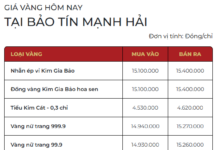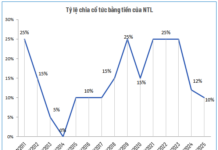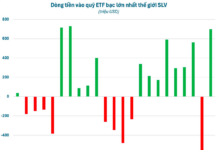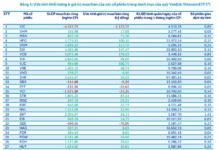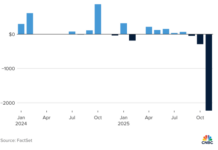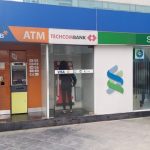At the seminar “Solutions to Protect Customers Using Banking Services” held by the State Bank of Vietnam in Hanoi on July 4, Vice Governor of the State Bank of Vietnam (SBV) Pham Tien Dung shared that on the first day of Decision No. 2345/QD-NHNN on the deployment of safety and security solutions for online and bank card payments took effect (July 1, 2024), the number of transactions at banks increased by 10-20 times compared to a normal day, leading to a transaction congestion situation at some banks. However, on July 2-3, the transactions were basically smooth.
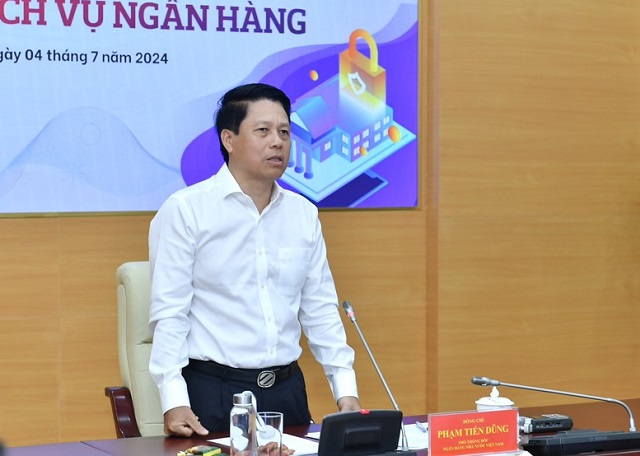
Vice Governor Pham Tien Dung speaks at the seminar – Photo: VGP/HT
|
To resolve the congestion issue and ensure convenience for customers, Mr. Pham Tien Dung – Vice Governor of the SBV, said that as of 5 pm on July 3, 16.6 million bank accounts had been checked and verified with the Ministry of Public Security’s data to eliminate fake accounts that are not owned by the accountholders or created with false documents. This number of 16.6 million accounts is equivalent to the number of accounts the banking industry opens for customers in a year of effective operation.
The SBV leader further shared that on the first day of Decision No. 2345/QD-NHNN on the deployment of safety and security solutions for online and bank card payments took effect (July 1, 2024), the number of transactions at banks increased by 10-20 times compared to a normal day, with an average of 1.8-2 million transactions worth over VND 10 million per day. This led to a transaction congestion situation at some banks. However, on July 2-3, the transactions were basically smooth.
“The situation of not being able to transfer money on the first day of implementing biometric authentication is real, but it has been gradually resolved in the following days. Up to now, it has basically stabilized and become smooth. Customers who do not have a chip-based ID card have been guided and supported by the bank when making transactions over VND 10 million. The SBV controls transactions every hour to monitor abnormal transactions,” said the Vice Governor.
Vice Governor Pham Tien Dung explained that the implementation of biometric authentication adds an extra layer of protection, making it definitely safer. In case customers lose their documents, and criminals try to use them to impersonate and defraud money at the bank, it would be difficult to do so as the biometric facial recognition can verify the true owner.
“On the bank’s side, even with biometric authentication, we do not skip any security steps, ensuring greater safety for customers. As cybercrime is becoming more sophisticated, technology must continuously improve to better protect customers’ assets,” emphasized the Vice Governor of the SBV.
According to statistics from the SBV, as of 5 pm on July 3, 16.6 million out of 170 million bank accounts have been checked and verified with the Ministry of Public Security’s data to eliminate fake accounts that are not owned by the accountholders or created with false documents.
According to the SBV leader, currently, over 87% of adults have payment accounts at banks, and many banks have processed over 95% of transactions through digital channels. Cashless payments have grown strongly, especially in the number of mobile and QR code payment transactions, with an average annual growth rate of over 100% from 2017 to 2023.
The interbank electronic payment system processes an average of VND 830 trillion per day (equivalent to US$40 billion), and the financial switching and electronic clearing system processes an average of 20-25 million transactions per day. The banking industry has closely coordinated with the Ministry of Public Security in crime prevention and has been a pioneer in effectively implementing the tasks of Scheme 06/QD-TTg of the Prime Minister: Approving the Scheme on the Development of Applications of Population Data, e-Identification, and e-Authentication to Serve National Digital Transformation in the period of 2022 – 2025, with a vision to 2030.
Enhancing security and effectively blocking fraudulent money transfers
 Seminar “Solutions to Protect Customers Using Banking Services” – Photo: VGP/HT
|
Regarding commercial banks, the SBV leader evaluated that Vietcombank is a pioneer in applying the electronic authentication service of the Ministry of Public Security, helping customers update biometric information through the VneID connection. Accordingly, Vietcombank customers can update their biometric information online through the app-to-app connection between the VCB Digibank application and VNeID. This provides customers with an additional option for updating biometric information, along with the use of chip-based ID cards and NFC-enabled phones.
A representative of Vietcombank added that to implement Decision 2345 of the SBV, commercial banks, including Vietcombank, have undertaken a significant amount of work. There are “combat” teams, building and implementing processes, communication and training, and ensuring 24/7 “combat” readiness.
Notably, just before the implementation of biometric authentication from July 1, Vietcombank officially launched the new-generation VCB Digibank digital banking service for individual customers. In addition to biometric protection, Vietcombank has also upgraded security layers for its customers. This is considered the largest update since its launch in 2020.
Ms. Nguyen Thi Quynh Giao, Deputy General Director of BIDV, said that it is true that on the first day of implementing biometric money transfers, people encountered problems and had to try 5 times before succeeding. However, the system gradually stabilized afterward.
“We have 7,000 staff trained to support customers 24/7 through various forms. As of last night, more than 1.7 million biometric authentications were successful, including 166,000 collected at the counter,” said Ms. Giao.
Mr. Luu Danh Duc, Deputy General Director in charge of the Information Technology Division of SHB Bank, emphasized that to thoroughly address the root cause of mobile app fraud, communication and education to customers must be strengthened, using multiple channels and more effectively, to raise people’s awareness and vigilance.
The bank also proposed the early establishment of regulations, processes, and coordination mechanisms between the Ministry of Public Security, the SBV, commercial banks, and payment intermediaries to timely prevent criminal money transfer activities.
SHB’s representative noted that after the COVID-19 pandemic, digital channel transactions surged, leading to a corresponding increase in attacks on customers and their devices.
Recently, criminals’ deception tactics have become more sophisticated with the use of AI Deepfake. Hackers collect customers’ images, videos, voice, and personal information and then use AI (Deep learning) to swap faces and create deep fake videos of the victims.
SHB has built a defense system to prevent cyber attacks and maximize the protection of the bank’s assets and customers’ assets within the system. SHB has continuously and strongly warned customers about fraud through various channels such as the press, SMS, push app, website, and at counters, along with measures to prevent fraud. In addition, the bank is further enhancing technical measures such as strong data encryption, application security, and strong authentication, including strict compliance with Decision 2345 of the SBV on biometric authentication for online transactions.
Regarding the prevention of Deepfake impersonation, SHB is also using AI and Machine learning and applying advanced biometric solutions. The bank’s IT team regularly conducts security testing and communicates with customers to raise their vigilance.
“Currently, SHB is striving to turn the mobile app into a ‘fortress’ to protect customers by designing intelligent functions to understand user behavior and detect abnormal activities, thereby helping to prevent fraudulent activities,” said Mr. Luu Danh Duc.
Mr. Nguyen Quoc Hung, Vice Chairman and General Secretary of the Vietnam Banks Association, affirmed that the common goal is for banks to build safe customer protection processes and coordinate closely with each other. Units must coordinate to ensure the safety of customers’ accounts, regardless of which bank the customers belong to.
In the past time, the SBV has completed the legal framework and issued three circulars that took effect on July 1, including Circular No. 15/2024/TT-NHNN (Circular 15) regulating the provision of non-cash payment services; Circular 17/2024/TT-NHNN (Circular 17) regulating the opening and use of payment accounts at payment service providers; and Circular 18/2024/TT-NHNN (Circular 18) regulating the activities of bank cards.
“We need to build common processes and coordination mechanisms among banks and the police to effectively handle issues when they arise. There must be criteria to identify fraudulent transactions. There should be unity among credit institutions, and in the near future, we will report to the SBV to issue guidelines to better ensure customers’ rights,” emphasized the leader of the Vietnam Banks Association.
According to Circular 17 and Circular 18, from January 1, 2025, if customers do not provide biometric data and have not been checked and verified, all electronic transactions will be stopped. The SBV affirmed that the condition for providing services on the Internet environment is that information must be biometrically authenticated with the Ministry of Public Security. The SBV’s goal for 2025 is to build and manage the entire system of accounts, cards, wallets, and payment acceptance units in the country. Accordingly, the SBV will provide a comprehensive assessment of each account for credit institutions based on whether there are issues or not, to support credit institutions in data cleaning, preventing suspicious fraudulent transactions.
Nhat Quang
Surge in QR Payments Leads to Bank ATM Closures
By the end of January 2024, the market witnessed a decrease of 1.70% in the number of ATMs compared to the same period in 2023, with a total of 20,986 ATMs. On the other hand, there was a significant increase of 32.68% in the number of POS machines, reaching a total of 554,580 POS. The month of January 2024 also saw a remarkable surge in QR code transactions, with a staggering increase of 892.95% in terms of quantity and an impressive 1,062.01% in terms of value.









